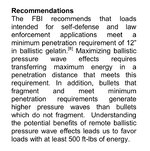This is long but bear with me. It pertains to recommendations for new hunters.
None of this data within this study is relevant to the end user. All it states is a hypothesis of ballistic pressure waves inducing injury and incapacitation, but it’s not a consistent metric for the end user. Bullet spin induces variances of damage as well, so does sectional density, every physical feature of the bullet and its impact. Depending on the bullets construction and size, the energy figure is all over the place. It makes no sense for an end user to calculate, and is a waste of time. Especially for a NEW end user.
This is 3 sceneries with 3 outcomes:
1) new end user buys a 308 and uses energy as the marker of effectiveness. This user will have success with some but not all projectiles, because the energy cutoff of say 1000ft/lbs is worthless with FMJ and other stout projectiles (also innacurate depending on levels of fragmentation). End user might become confused as to why their energy figure is not performing consistently across all calibers and bullet types… High confusion, low confidence.
2) new end user buys a 308 and uses the velocity cut off points stated by the manufacturer as the marker of effectiveness. This user will have success with most all projectiles that have been advertised correctly and aren’t defective. End user will have a good understanding of which bullets perform at what velocities… Low confusion, high confidence.
3) new end user buys a 308 and uses the velocity cut off points stated by the manufacturer, as well as a 1000ft/lb cut off point as the marker of effectiveness. This user will have nearly identical success to end user 2, however there will be certain instances he has unnecessarily limited himself in range due to the energy figure. As your study states, fragmenting projectiles require a lower energy figure… low confusion, high confidence.
There is an additional problem with new user 3. Many new hunters likely already have a gun; statistically speaking, probably an AR. By including the energy figure as a requirement, this user will now have to spend an additional $700-1500 on a new rifle and optic to meet that energy requirement, when there is heaps of evidence that the AR they always have is adequate at the ranges a new user would shoot. They’re not going to know all the little exceptions to energy requirements based on fragmentation. Clearly we don’t even fully understand it, just that there is a correlation. That person could have used that money for other equipment, ammunition to practice, or some other improvement in their life. The only difference that energy figure adherence did vs example 2, was cost the end user an unnecessary purchase of $600-1500 for perceived security. No change in reality of outcome.
This begs the question… why? It may be relevant to a ballistician but why does it even matter to the end user? If the results will be nearly identical between user 2 and 3 why pay attention to it? Why waste the time to calculate the required energy for every bullet type and caliber? Clearly based on bullet upset it changes, as in the case of fragmenting projectiles only requiring 500ft/lbs… well how much fragmenting? Does one require 650ft/lbs, another 700? They don’t all fragment the same. TMKs have thicker jackets with wider hollow points than ELDMs. OTMs are different still. 55g 556 will fragment unpredictably above 2700fps, but they’re not one for one the same, therefore between 500-1000ft/lbs, for fragmentation there would be variance. There’s also variance of fragmentation based on impact speed and target resistance (full stomachs, bone, etc).
Bullet spin has an effect on impact, 8.6 blackout shows this. Why not calculate that as a cut off too? Or sectional density which affects penetration. Or lubricity. Or any other variable?… because it’s not consistent, we have better metrics for consistency, its a waste of time.
Running just a few calculations from 223, 6.5, and 338 shows energy cutoff values are wildly different across the velocity spectrum. Ammunition manufactures provide velocity cutoff points as the most convenient marker for bullet performance, because why complicate it? It’s the same number across all bullet sizes of a single bullet type. There’s not a single box of ammunition that states a minimum energy requirement, because it’s complicated.
Anyone’s free to apply energy figures to their requirements. You can apply anything that helps your confidence level. However It is not logical to imply that a new shooter should too. Paying attention to velocity alone will deliver the exact same results with less data. If you just want the bullets to perform as designed, pay attention to velocity. Leave energy to the ballisticians, it’s just unnecessary noise to the end user. It just adds confusion, the proof of which is the endless debating of its relevance. There is no debate on velocity relevance, it’s essential.
Keep It Simple Stupid. Velocity is not the only marker of wounding, but it is the most stable and consistent metric we currently have.
Having said this, I’ve hunted with a lightweight 16” 308 exclusively for the past 6 years. I use AMAXs and TMKs, both in the 160 range. I would NOT recommend it to a new user with the options we have today.





